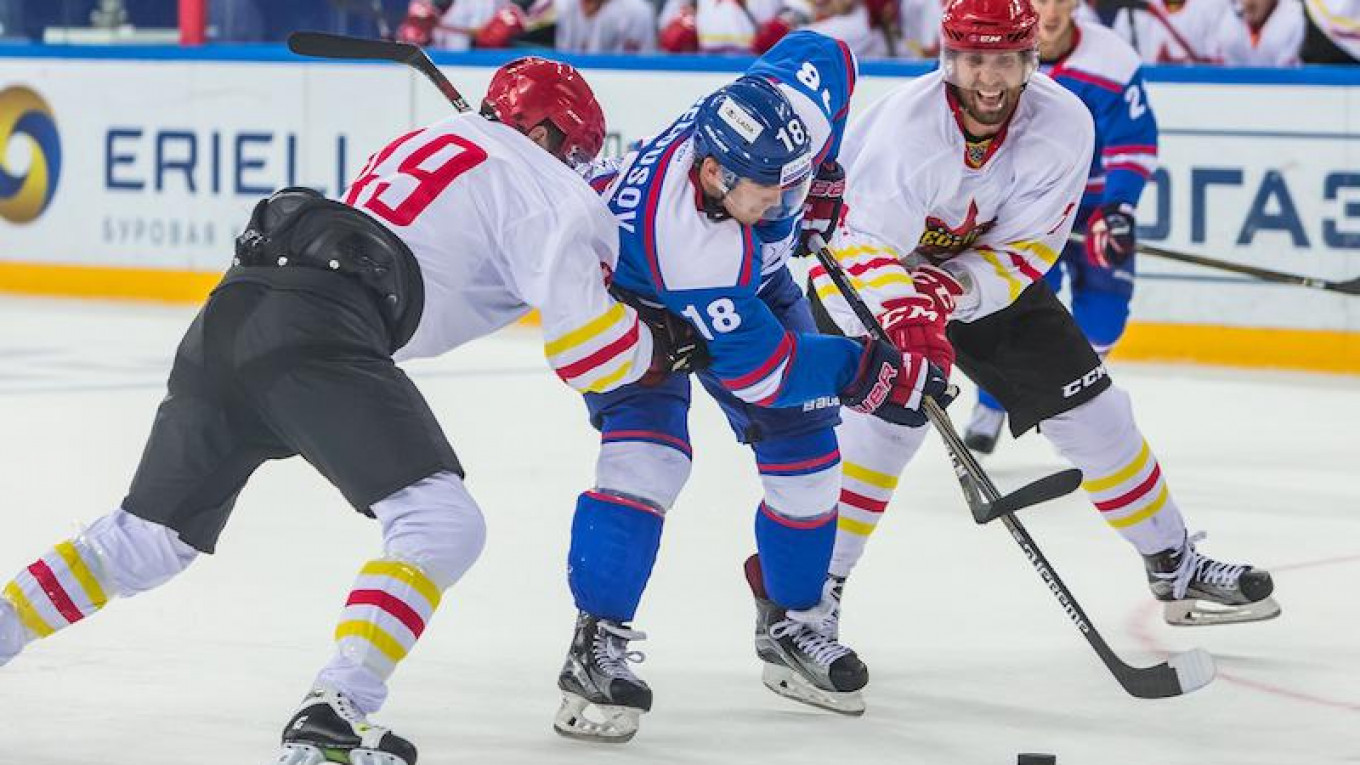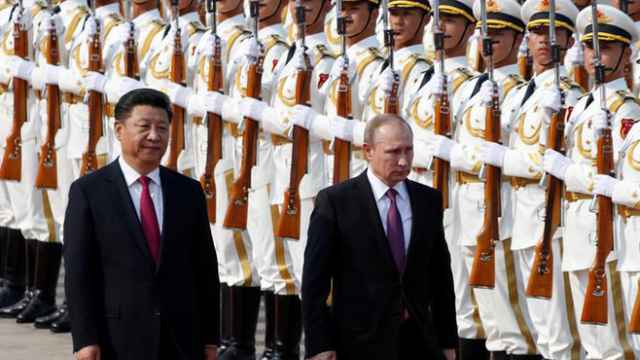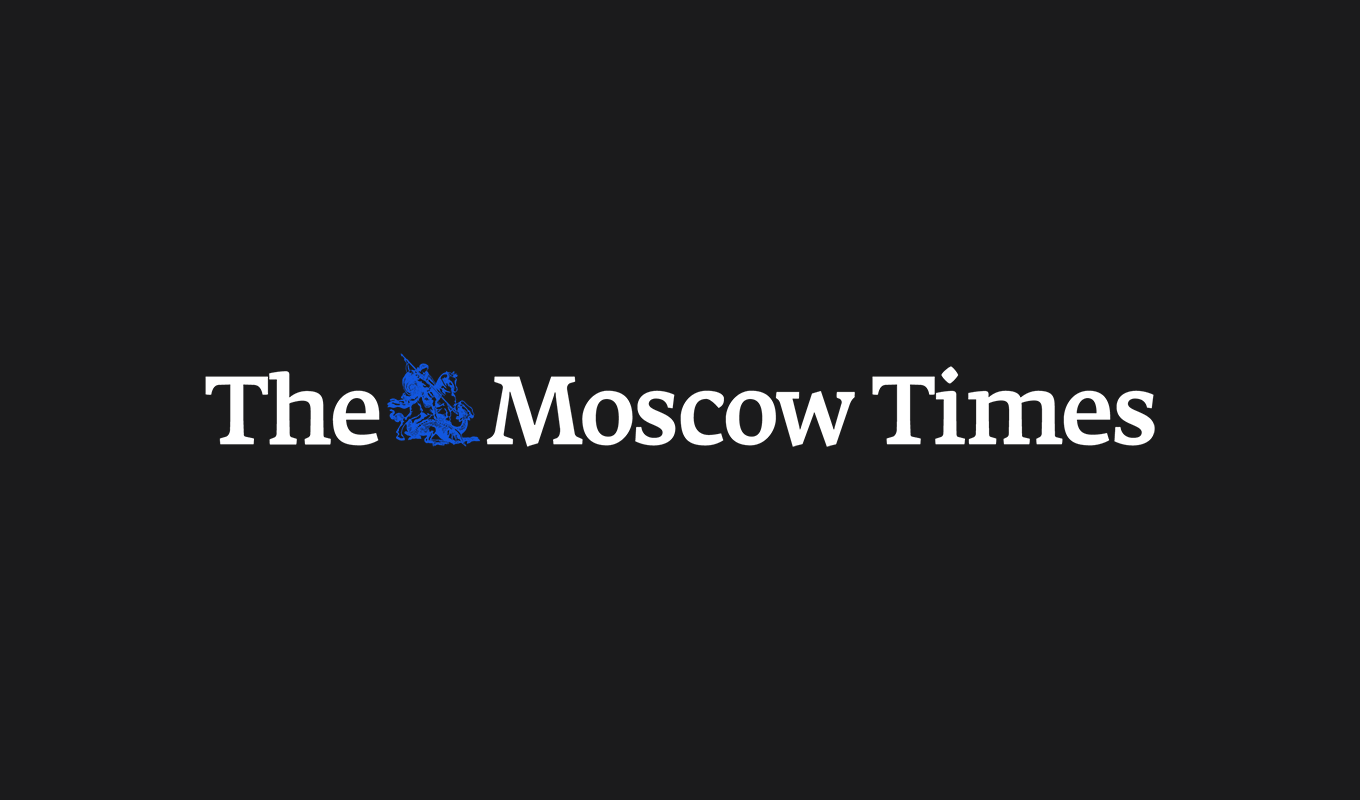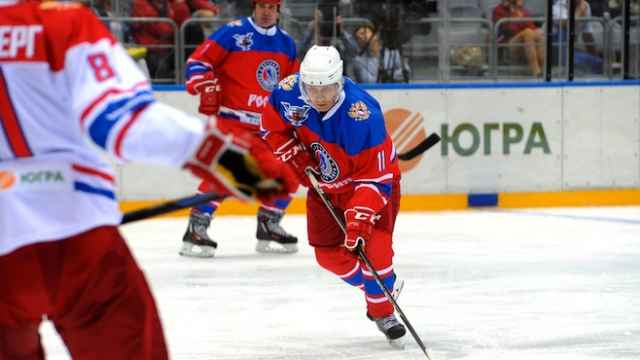After three straight preseason losses, Beijing’s Red Star won their first match in the Kontinental Hockey League (KHL). Barely six weeks old, they toppled Kazakhstan’s Barys Astana 3-1, prompting a team-to-team fight. Three days later, when the two teams met again, it was clear that a new KHL rivalry has been born.
It was the first game of Kazakhstan’s President’s Cup—a traditional curtain-raiser for the KHL season in late August. Tension between the teams was apparent within the first three minutes. Astana player Dmitry Rypsayev tried to single-handedly fight the entire Red Star roster, and saw some success.
Going into this Aug. 8 match with just 23 games of KHL play under his belt, Ryspayev had yet to score a single goal. But with 194 minutes spent in the penalty box during that time, the young Kazakh’s genius for on-ice violence was clear. Red Star didn’t have anyone on their roster to match that kind of pugilistic talent. The team’s Russian coach, Vladimir Yurzinov Jr., pulled his players from the ice.
It was a strategic decision: accept a forfeit and ensure the team is healthy enough to fight another day. This matchup was, after all, intended to be a friendly preseason game and trial run leading into the Aug. 22 start of the KHL season. For Red Star, these games were also intended to set the stage for their arrival in Beijing for their first home game on Sept. 5.
Fighting would give the new Chinese audience the wrong idea about hockey, the KHL reasoned. When the league decided to hand Ryspayev a lifetime ban on Aug. 18, it used precisely those reasons to justify it. While there is a place for fair fighting in hockey, said KHL President Dmitry Chernyshenko, there is no place for Ryspayev’s assault on the “newcomer.”
“We are constantly working to attract a new audience and broaden the game’s geographical reach,” Chernyshenko continued, “and Ryspayev’s behavior is not merely harmful in a sporting context, it also blackens the image of the league.”
The Great Game
Kunlun Red Star, as the team is officially known, is China’s first team to join the Russian-dominated KHL. Behind the National Hockey League (NHL), the KHL is widely regarded as the second most competitive hockey league in the world. While there has been talk for over a year that Beijing was trying to assemble a KHL team, Red Star only joined the league on June 25.
The ceremony inducting Red Star into the KHL was picturesque. Russian President Vladimir Putin, in Beijing for a series of high-level state negotiations, sat next to his counterpart Xi Jinping. The two watched as KHL Vice President Roman Rotenberg and chairman of the KHL board Gennady Timchenko— both longtime Putin allies—signed a formal agreement with Red Star’s management.
Ostensibly a Chinese team—ownership remains murky—Red Star is coached and managed by seasoned Russians. The club has an explicit mission: to play a central role in developing Chinese hockey ahead of Beijing’s hosting of the 2022 Winter Olympics, says Red Star General Manager Vladimir Krechin.
Hockey is one of the contest’s most prestigious events, and Russia has been one of the world’s preeminent hockey powers for decades, with the Soviet national team famously dominant at international competition. In this way, teaching China hockey is one of the few areas of the Russia-China relationship where Moscow can confidently play the coveted role of senior partner.
“I see Red Star as a club that will bring ice hockey in China to the next level,” Krechin says. “The partnership will involve much more than just building one professional club. There is a vast, long-term program covering everything: youth programs, coaching programs, international tournaments for different levels, and much more.”
The man tapped to spearhead this effort was Russian
hockey coach Vladimir Yurzinov Jr., the son of a famous Soviet
hockey player. His role is a critical one in Red Star’s political
goodwill mission. By building a team that can play what
he calls “attractive hockey,” Chinese fans can discover a sport
they can get behind, and the sport’s infrastructure will fall
into place.
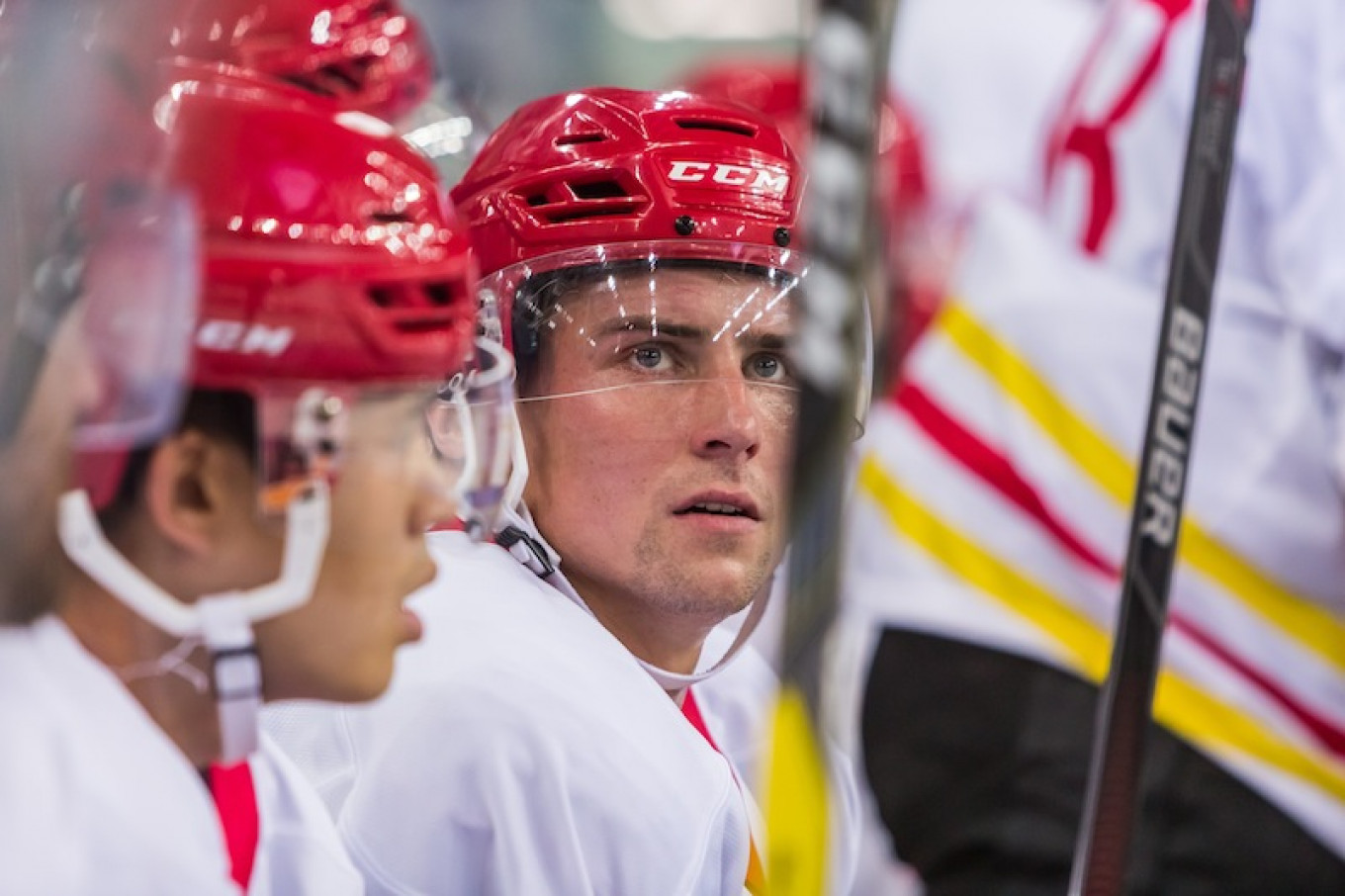
Red Star Rising
“It is impossible at this moment to find Chinese players good enough to form an entire team,” Yurzinov says. KHL regulations stipulate that at least 10 players represent the host nation, or are otherwise Russian. The team is then free to pad out the remainder of the roster with experienced NHL players and veterans from the KHL.
According to one of the team’s Chinese recruits, 18-yearold Rudi Ying, the problem is mainly a difference in approach. “The basic mistake Chinese players make, he says, “is treating hockey like a skill sport, not a contact team sport.”
The difference became apparent to Ying 10 years ago, when his family moved to the United States and he entered the youth league system there.
They also lack what Ying called “game sense” and a sense of competitiveness. This stems from the typical Chinese season schedule. During the crucial stretch from ages 12 to 18, Chinese players will play no more than 20 games a season, while kids in the United States and Europe typically play anywhere from 60 to 80 games.
But in the decade since Ying left China to play in the United States, support for the game has steadily grown. China has fielded teams in the less prestigious Asia League Ice Hockey (ALIH), and has a decent elementary school training system. The problem is in training players through high school and into college. The idea is for Red Star to eventually form an academy to fill this gap.
Meanwhile, Yurzinov’s Chinese players, like Ying, must be the vanguard of a new generation of Chinese hockey talent. It is likely that Red Star players will in six years be called upon to form the backbone of a Chinese national team at the 2022 Beijing Olympics. “I see it as my duty to help the development of Chinese hockey,” Ying says, expecting to heed the call down the line.
“The only reason hockey is not popular in China is that people don’t know about it. I think once they see it, they will fall in love, and Red Star is really going to help with that,” he says. In the short term, this will be handled by Red Star’s foreign players. Even rookie Russians like Alexander Mikulovich say they have been encouraged to pass along their skills.
“The owner came in one day and said to us: ‘Guys, I know that the Chinese players are not as good as you, but just try to be nice to them. And, if possible, teach them some stuff,” Mikulovich says.
While this might sound patronizing to
some, Ying said it was the key selling point
that drew him from the traditional North
American developmental leagues to the
KHL. “I had a long conversation with my
agent about how the guys on the team are
going to take me under their wing. Some of
them have close to 10 years experience on
me, and they’ve been really helpful,” he says.
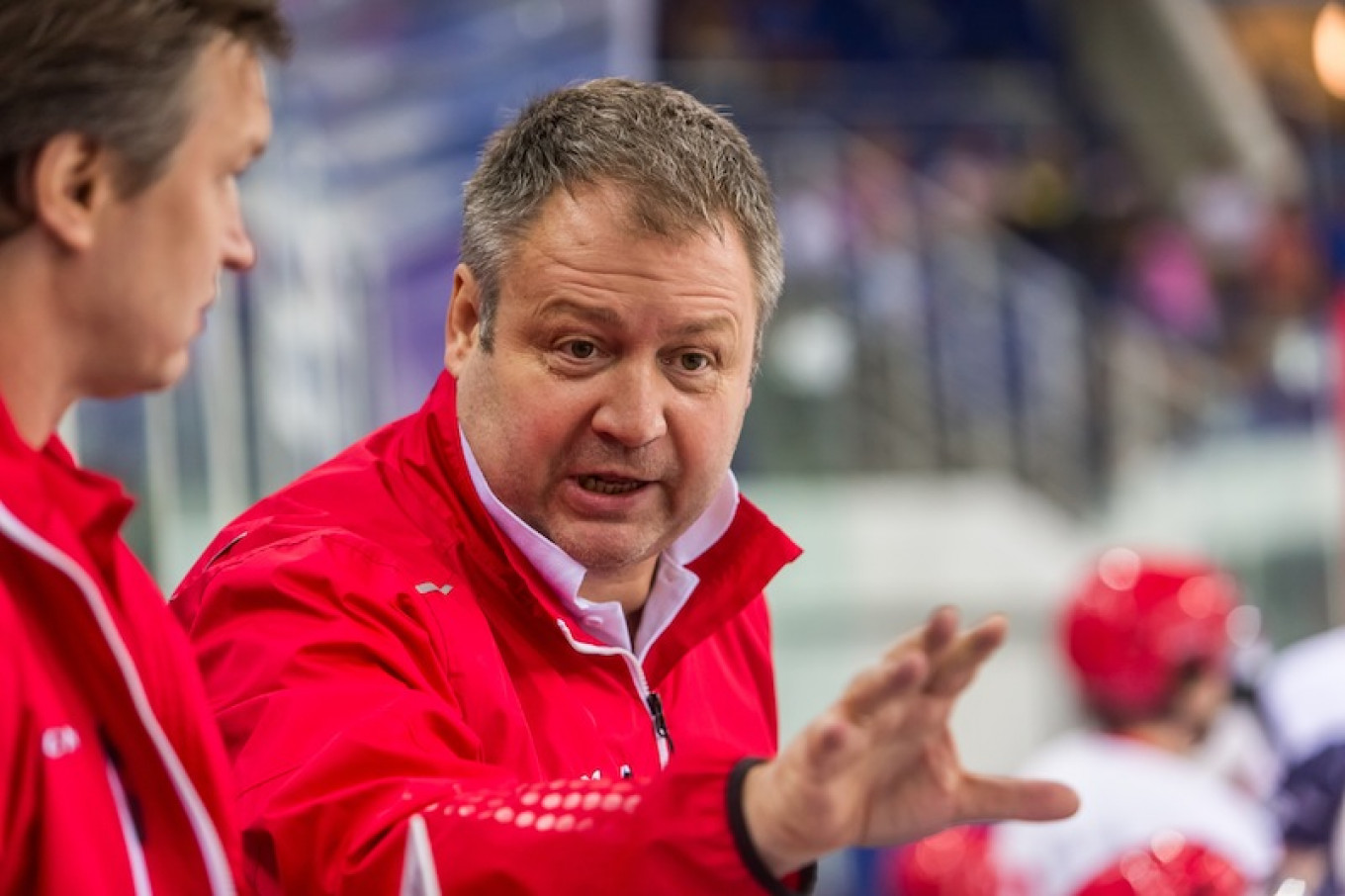
While Yurzinov and his players are looking to bring their Chinese teammates up to their level, the coach needs to ensure he has a team that can win. If Red Star is unable to develop into a competitive organization, the entire project could fail. “No one expects heroics from a newborn team, but who wants to be a bunch of clowns on ice? Who wants to lose day after day?” he says.
And so, as Red Star prepares for its first game of the KHL season in Khabarovsk on Sept. 1, the coaching staff continues to play with its roster. The latest rumors circulating online are that Red Star is courting its own answer to KHL hit men like banned Astana player Ryspayev.
On Aug. 18, KHL sportswriter Aivis Kalniņš wrote on Twitter that the club made a contract offer to infamous Canadian enforcer Brian McGrattan. The former NHL player holds a dubious record in the lesser American Hockey League (AHL): most time spent in the penalty box during one season, standing at 551 minutes.
Next time Red Star has to fight, it will be ready.
A Message from The Moscow Times:
Dear readers,
We are facing unprecedented challenges. Russia's Prosecutor General's Office has designated The Moscow Times as an "undesirable" organization, criminalizing our work and putting our staff at risk of prosecution. This follows our earlier unjust labeling as a "foreign agent."
These actions are direct attempts to silence independent journalism in Russia. The authorities claim our work "discredits the decisions of the Russian leadership." We see things differently: we strive to provide accurate, unbiased reporting on Russia.
We, the journalists of The Moscow Times, refuse to be silenced. But to continue our work, we need your help.
Your support, no matter how small, makes a world of difference. If you can, please support us monthly starting from just $2. It's quick to set up, and every contribution makes a significant impact.
By supporting The Moscow Times, you're defending open, independent journalism in the face of repression. Thank you for standing with us.
Remind me later.


